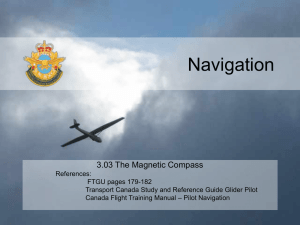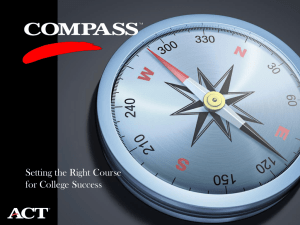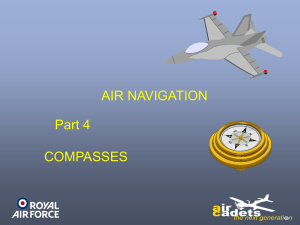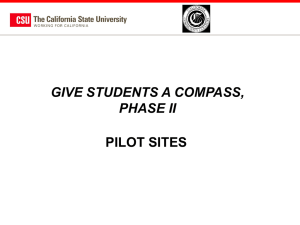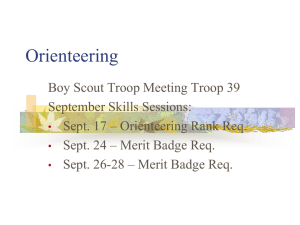Presentation1- basic navigation
advertisement
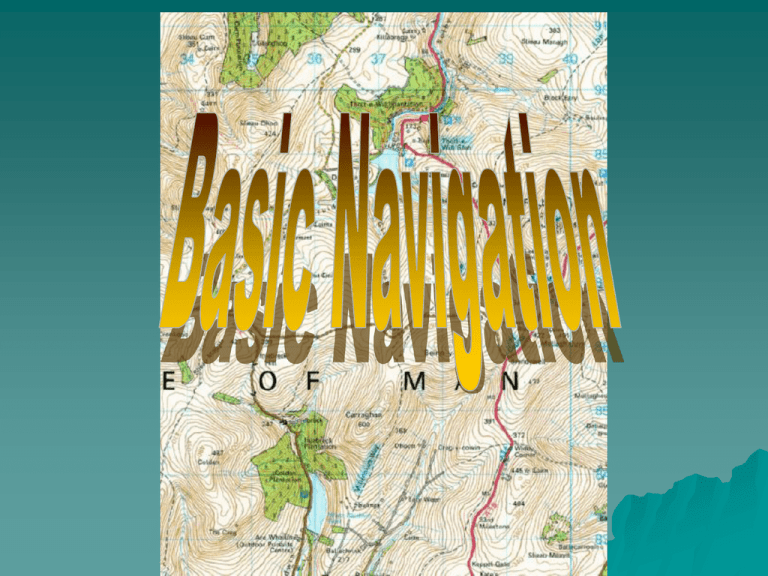
What is Navigation? Good Navigation is knowing: Where you are on the map Where you want to go How to choose the best route to follow What is needed? Good map reading skills Good compass work True North or Grid North? An OS map has grid lines which enable you to identify a small area by its grid reference. Grid lines cover a flat surface (the map) and so are regular. However, lines of longitude and latitude cover the curved surface of the earth with the lines of longitude getting closer and closer together as they reach the North and South poles. What does this mean? Grid lines do not actually point to True Northinstead they point to an imaginary point called Grid North. (The difference is insignificant and is no more than 2) In navigation you must always use Grid North as your reference Setting or orientating your map Orientation of your map by eye Turn your map in such a way that identifiable features on the ground are in their correct position relative to the map. EASY TO PIN POINT POSITON AT ANY TIME (It should become easier for you to see changes in direction, junctions and the appearance of features which will confirm your actual position.) Finding North without a compass 3 methods for finding north without a compass 1. The Pole Star In the northern Hemisphere the direction of the north pole is indicated by the position of the Pole Star. First find the Great Bear or Plough and then follow the pointers to the Pole Star 2. Using a Watch Looking at the sun, hold your watch horizontally with the hour hand pointing at the sun. Now bisect (halve) the angle between the hour hand and the 12 o’clock position. This line points due south. In British summer time (Apr-Oct) bisect the angle between the hour and the 1 o’clock position. 3. The Shadow Method This method can only be used if the sun is shining significantly to cast shadows. Place a stick upright in the ground and mark the end of its shadow using a small stone. Wait for 10-15 minutes and use a second stone to mark the new position of the stick’s shadow. A straight line between the two markers runs roughly west to east. Magnetic North The Earth’s magnetic north pole does not coincide with its geographical north pole (true north). In the British Isles the magnetic north pole is presently about 5west of true north. The magnetic variation as it is called is different in different parts of the world and must be allowed for when using a map and compass for navigating. To help you, the magnetic variation is always displayed on the bottom of an OS map. To further complicate things the magnetic north is not fixed and moves very slowly and changes position a little each year. This movement can be predicted and adjustments made to compensate. The GRID MAGNETIC ANGLE (GMA) is the angular difference between the grid north and the magnetic north and is displayed on every OS map in the centre of the top margin. Questions Answers The Compass The Silva Compass Main parts Free moving magnetic needle – half red (points North) half white (points South) Direction of travel arrow on compass plate 360 marked around the rim Orientating lines marked on its base A rotating capsule filled with a fluid to ‘damp’ the compass needle Careful not to drop and store it away from electrical appliances that contain strong magnets (e.g. TV, telephones etc..) Magnetic Deviation Your compass needle is a small magnet and will be affected by ferrous metals placed close by. Your magnet will deviate from its true position- so take care when using your compass. Try the following: Setting the map with a compass Turn the compass capsule until the grid magnetic angle (GMA) is set against the direction arrow (say 6) Place the compass onto the map so that the long edge of the compass matches the N-S grid lines and the direction of travel arrow points to the top of the map. Turn the map and compass TOGETHER until the compass needle falls inside the orientating arrow – red end pointing North Setting a compass heading Compass Bearings If you are unable to identify features to set your map you can use your compass. (E.g. You are at GR 042 166 on the map and you are planning to walk to the church at GR 067 192) Setting a compass heading 1.Place the compass on the map with its long edge running through both points and the direction of travel arrow pointing in the direction you wish to travel. (You do not need to set the map for this operation) 2. Hold the compass plate firmly in this position and turn the compass capsule until the orienting lines on its base are parallel to the north-south grid lines and the orienting arrow points to the top of the map. Setting a compass heading 3. The compass now registers the number of degrees between grid north and your intended direction of travel. Now you must add the GMA (say 6)- so turn the capsule to add another 6. 4. Remove the compass from the map and hold it in front of you so that it is level and the direction of travel arrow points away from you. Rotate your body until the magnetic needle falls within the orienting arrow on the base of the capsule- red end pointing north. Setting a compass heading 5. The direction of travel arrow should now point in the direction you need to walk. REMEMBER ADD GRID to MAG - Walking on a bearing Always choose a feature in the far distance- possibly on the horizon, and walk to that – Avoid walking while staring at your compass! If it is poor visibilitysight on an object at the limit of you visibility, a rock, a bunch of reeds. As you approach your chosen object, others will appear behind it and in line with it. Use these continually appearing objects to do your straight line compass march. Transferring from compass to map You can take a compass bearing and convert it to a map bearing in order to identify a feature or to help pinpoint your position. (E.g. You are on the path at GR 051 179 and you see a church in the distance that you want to identify on the map) Transferring from compass to map 1. Point the direction of travel arrow at the distant church. 2. Hold the compass in this position and turn the capsule until the orienting arrow lies directly beneath the north end of the compass needle. This gives the magnetic bearing. 3. Now turn the capsule to deduct the GMA (6). This now gives the grid bearing. 4. Place the compass on the map (you do not have to set the map) with its long edge passing through your present position, on the path at GR 051 179. DO NOT TURN the capsule. 5. Pivot the whole compass around your position until the orienting lines are parallel to the north-south grid lines and the orienting arrow points to north on the map Transferring from compass to map The edge of the compass that runs through your position should now run through, or point at, the symbol for a church you can see in the distance. REMEMBER MAG to GRID – get RID Resection – Finding where you are If you have a vague idea where you are on a map and wish to determine your position more accurately You must be able to identify at least 3 features on the ground around you (i.e. the edge of a wood, a church and a hill) Resection – Finding where you are Take each feature in turn, take its compass bearing, convert it to a grid bearing and plot its position on the map. Draw a faint pencil line along the long edge of your compass so that it passes through the known feature. Repeat this for the two other features and the point where all 3 lines cross marks your position. (The lines rarely meet at a point; take position as being near the centre of the triangle formed.) Scales and Roamers Using a RoamerA Roamer is used to find a 6 figure grid reference more accurately than by estimation. You must have the correct roamer scale for the map Place the corner of the correct roamer on the map feature whose reference you want, then read from where the scales intersect the grid lines. Always read the nearest low figure (SW corner) Measuring distances on a map Use dividers-Measure distance between two features on the map by opening the dividers to touch each feature and then transfer this measurement onto the scale at the bottom of the map. DO NOT PUNTURE THE MAP! Straight Edge of PaperPlace the piece of paper between the features on the map and mark their position on the paper. Now line this up with the scale at the bottom of the map. By placing your paper on the scale so that the right hand mark is on a whole number of units, the second mark should fall on the tenths to the left of the zero. Answers Using this map answer the following Using this map answer the following Practical Navigation Measuring distance on the ground There are two ways to estimate distance: Timing b) Pacing a)Timing – How long does it take you to walk 1 km? If you know how fast you walk, then you should be able to work out how long it will take you to cover a known distance. Speed =distance / time Therefore time = distance / speed E.g. If you need to walk 2 km and you can walk at 4 km/h. How long will it take you? Time = 2 km / 4 km/h = 0.5 h or ½ hour Things to consider Going Uphill – Naismuth’s rule Add ½ hour for every 200 m of climbing Going downhill – extra timing for climbing usually cancels with faster walking on descents. However, very steep descents may require more care. In this case: Add 10 minutes for every 200m in steep descent Things to consider Fitness – A group can only move at the speed of the slowest member. Terrain – It is not always possible to tell from a map just how rough the terrain will be. Marshes, boulder fields and forest can all slow walkers down. Unsure of Terrain – Allow for slow progress Load – Carrying a heavy pack can slow a walker by as much as 50% of normal speed. Heavy Load – Reduce overall speed to 3 km/h or even 2 km/h Pacing Counting paces – This involves counting paces over short distances only. -Count number of double paces (each time the same foot hits the ground) -Different terrain will require adjustments Errors Try to be as accurate as possible – errors in both distance and direction could result in huge uncertainties after only short distances. Error of ± 10% for distance Error of ± 4 for direction RESULT – Huge AREA of uncertainty After 1 km uncertainty 4 football pitches After 3 km uncertainty 36 football pitches!!! Keep the legs of your route as short a possible Practice compass work Practice Pacing and timing distances Good Navigational Techniques 1. Handrailing- This technique uses easy to follow linear features to direct you to your final destination. The linear feature is used as a ‘handrail’. Use ‘handrailing’ to get you from position A to the camp site. Good Navigational Techniques 2. Aiming off- Imagine you are at point A and you want to cross the river at the bridge. Aiming directly for the bridge – chances are that you would miss it, and you would not know to turn upstream or downstream to look for the bridge. Aiming off slightly to one side- you would then know which way to turn when you hit the stream. Good Navigational Techniques 3. Contouring Is it better to go round a hill or up over the top? The two routes may take the same time, but contouring round takes less effort. To considerContouring requires very careful navigation, particularly in poor visibility (tendency to lose height and to travel too far around the curve) Good Navigational Techniques Try this: The route around the spur is 4 km and will take you about 1 hour to walk. The route over the hill is only 2 km long but you have to climb 200m Use Naisth’s rule, how long would this route take to walk? Good Navigational Techniques 4. Attack points Aim for an easily identifiable feature close to your target. It pays to go slightly out of your way to hit a definite target, in order to increase your chances of reaching your final objective successfully. Questions Answers About weatherOn expedition you are very much at the mercy of the weather (elements) You must learn how to exploit the weather and work with it rather than against it. (e,g, choosing route with wind at your back, altering route to take in summits not shrouded in cloud or setting up cam before the heavens open) Knowledge of weather is required Listening to the daily and local forecast is vital – start a week before you go and also get the very latest version for your specific area. Unfortunately weather has a habit of changing rapidly You must be able to predict the weather as you go Main Air Masses Polar Maritime – picks up water vapour Summer – cool winds, heavy thunder showers, thunder storms in mountains Winter – Heavy showers in west with snow in mountains. Clear skies at night in the east giving frost Returning Polar Maritime- wetter that polar maritime air Summer- Warm with squally showers and storm inland Winter – Stratus cloud. Showers in the western mountains Tropical Maritime – brings warm wet air Summer – Warm south-west winds. Low stratus cloud over west coast. Winter - Stratus cloud, hill fog and drizzle, clearing in the northwest. Warm with prolonged rainfall in westerly mountains Tropical Continentalwarm air - not able to pick up moisture Summer only – Very hot and dry, hazy with occasional thunder storms Arctic Maritime- very coldnot able to pick up moisture as it travels south Summer – Very cold with frequent heavy showers. Winter – Very cold strong north, north-easterly winds. Heavy snow showers in north. Polar Continental- very cold in winter, warm in summer – Southern England not able to pick up moisture, Scotland – crosses more water therefore picks up more moisture. Summer- Warm and dry, cloud free. East coast tends to be cool and showery with coastal fog in the north Winter – Sleet and snow showers in the north. Cold strong east winds Fronts and Frontal Depressions Isobars – lines which join areas of equal pressure Close Isobars – Strong Winds Spread out Isobars – Light Winds or breezes Areas of Low Pressure – Called Depressions or Lows – The winds circulate in an anticlockwise direction- generally poor weather Areas of High Pressure – Called Anticyclones or Highs – The wind circulates in a clockwise directiongenerally warm dry air bring periods of fine clear weather. Warm and Cold Fronts- When two air masses meet, instead of mixing together, the less dense warm air tends to rise over the cold more dense air causing a drop in pressure. The cold air rushes in to fill the gap, producing a circular motion toward the centre of the depression. In northern Hemisphere- It goes in a anticlockwise direction. RULE – stand with your back to the wind, the low (and worst of the weather) is on your left. Occluded Front – When a Cold front catches up with a Warm front. This forms a continuous layer of cold air at ground level with the warm air on top. Position A with your back to the lower wind and the upper wind is moving left to right – the depression has not yet reached you and the weather is likely to deteriorate. Position B with your back to the lower wind and the upper wind is moving from right to left, then the depression has passes and the weather is likely to improve. Position C and Position D with your back to the lower wind is either moving toward you (at D) or moving away (at C), then there is likely to be little immediate change in the weather. Clouds 3 main types of clouds a) Cirrus- found only at high levels and are composed of ice crystals b) Cumulus- a lumpy or heaped cloud c) Status – featureless layer of cloud Questions Answers



